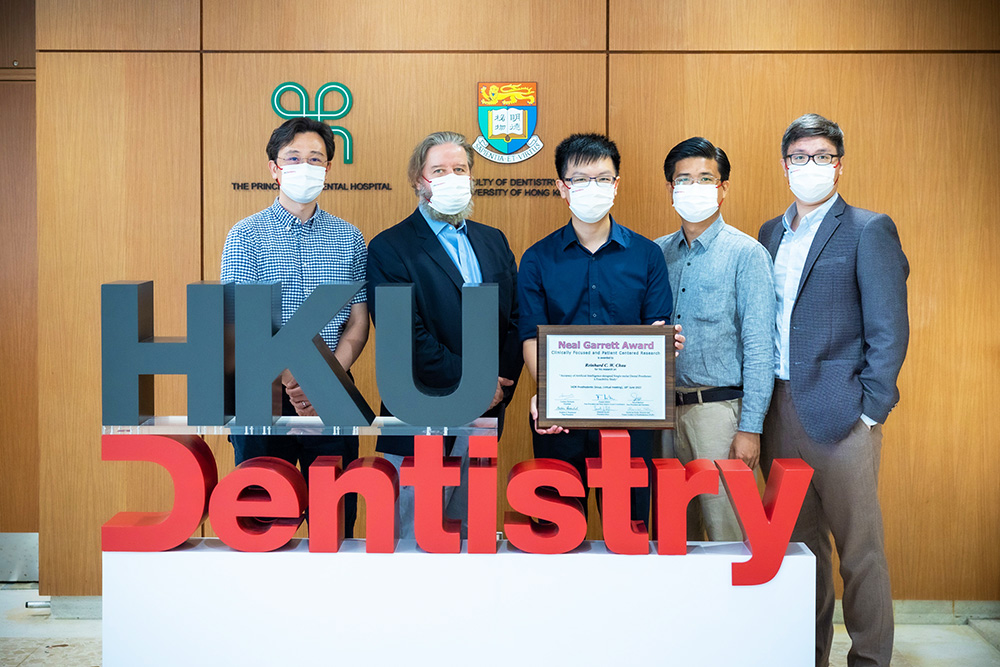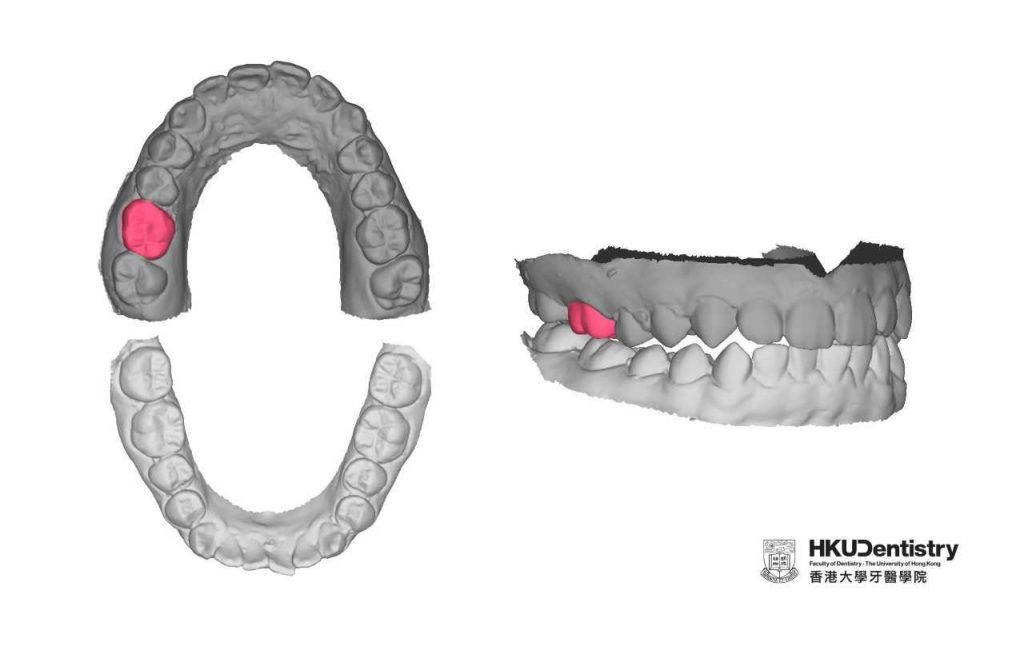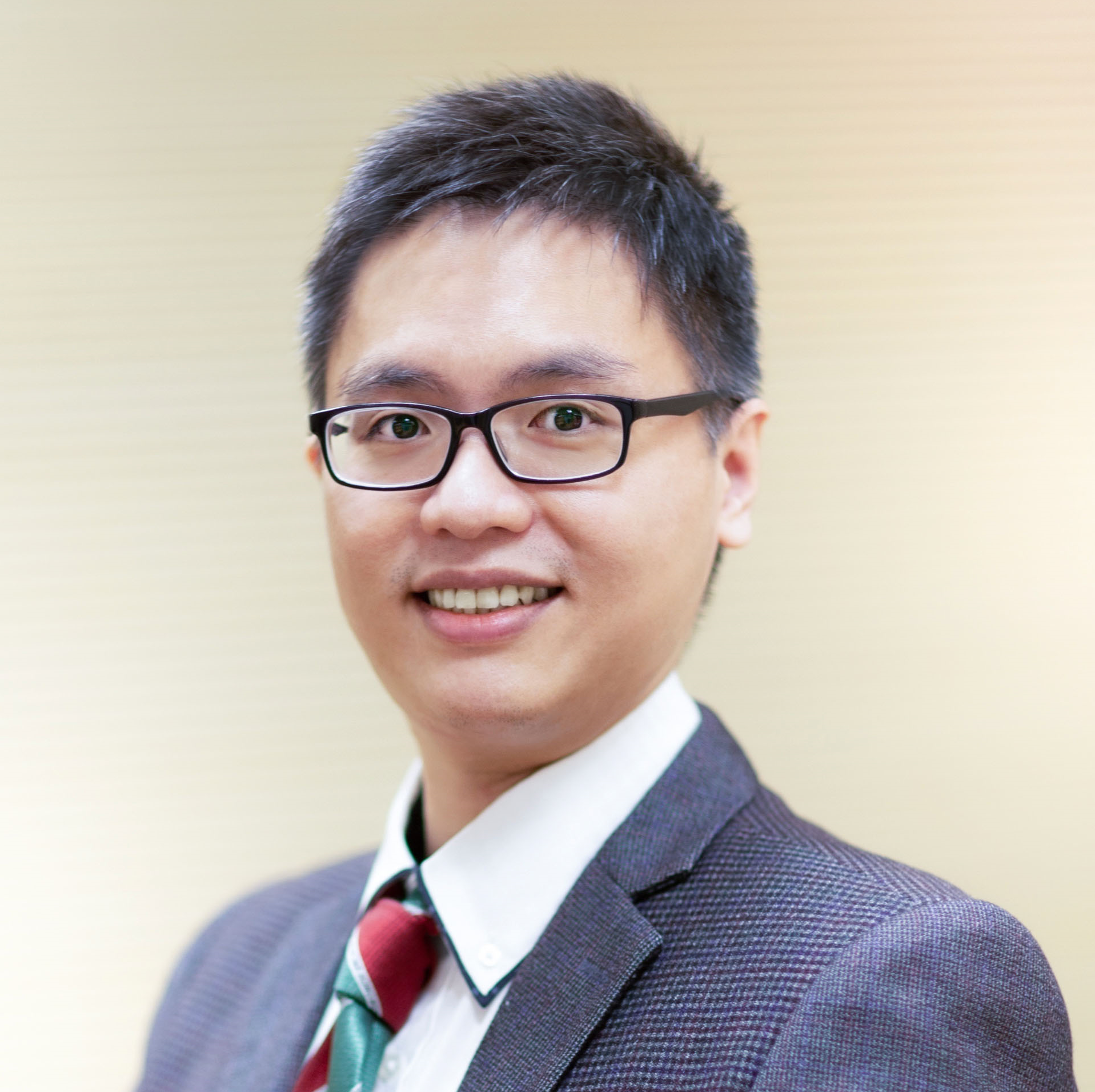May 2023 | Volume 24 No. 2
Less Pain, More Gain
One of the biggest problems with tooth replacement – particularly for the patient – is the amount of time it takes and the discomfort involved. Multiple fitting procedures can be tedious and uncomfortable. From the dentist’s viewpoint, existing design processes can involve a great deal of manual inputting on the computer.
Researchers from the Faculty of Dentistry at HKU have teamed up with the Department of Computer Science of Chu Hai College to investigate the effectiveness of using AI technology based on 3D Generative Adversarial Network algorithms to automate the design of artificial teeth to a very high degree of accuracy. They tested their ideas on 175 participants recruited at HKU.
Principal Investigator Dr Walter Lam, who is Clinical Assistant Professor in Prosthodontics, said: “Designing artificial teeth is labour-intensive and therefore expensive. Clinically, dentists need to record patients’ features – such as how the opposing teeth work in static and in function – and then send this clinical information to a dental technician to simulate the patient’s mouth.
“Dental technicians design and fabricate artificial teeth, and some already use computer-aided design (CAD) software. However, most of the resulting designs do not fit into the patient’s mouth properly and require significant and often lengthy adjustment by dentists at the chairside. In addition to being unpleasant for patients, the adjustment often weakens the artificial teeth.”
He describes the biting (occlusal) surface of teeth as being like ‘hills and valleys’ – with cusps and fissures – that are particularly complicated. “The slope/steepness of these cusps are different in different individuals, making this more complex as teeth will occlude (bite) with opposing teeth and patients can sense a minute difference in the biting surface up to a hair-like thickness,” he said. “We believe that it is difficult – if not impossible – for humans to identify such minute details.”
At the same time, however, teeth within an individual do share similar features, since they are controlled by the same set of genes and share similar environmental factors. Hence, the team proposed using AI to learn the features of individual teeth in a subject and apply these features to design artificial teeth for that subject. “We hoped that the AI-designed artificial teeth would mimic the healthy natural teeth in morphology as well as function,” said Dr Lam. “Treatment costs will be reduced and the function and longevity of artificial teeth will increase.”
For the research, the team selected subjects who had healthy natural teeth with almost full dentition – that is, almost no missing teeth. The subject’s teeth were then digitised via 3D scanning, and one back tooth, the right first permanent molar, removed from the resulting digital teeth models.
“We then input one digital teeth model (with one tooth removed) and its original model (all teeth) as a pair and the AI is able to design artificial teeth based on learning the features of the remaining teeth,” said Dr Lam.
“We are the first team in the world to use AI to design artificial teeth that mimic nature’s teeth. We believe nature is the best and only AI is able to learn such minute features for an individual in an effective way.”
Following the success of the study, a start-up company has already been set up with support from the Technology Start-up Support Scheme for Universities (TSSSU) and Hong Kong Science and Technology Parks Corporation.

From left: Dr Richard Hsung, Professor Colman McGrath, Dr Reinhard Chau, Dr Khaing Myat Thu and Dr Walter Lam.
AI design service
“When making artificial teeth, dentists provide all clinical information including teeth models to the dental technician for fabrication of artificial teeth,” said Dr Lam. “We plan to launch an AI crown design service in the near future, by which dentists can tick a box in the prescription form to use AI design service (versus manual design with or without CAD software). Then the dental technicians send us the teeth model with missing teeth and our AI can design artificial teeth by learning features of the remaining teeth.
“Expenditure should be low because we only need to set up an AI system, which is a normal server costing only about HK$100,000 plus system maintenance fees. After that, there is no cost difference between designing one or one million crowns. We plan therefore to charge only a few hundred Hong Kong dollars. Moreover, our AI system can provide services not only in Hong Kong but all over the world via the use of the digitalised teeth model.”
Now, the team plans to move from single tooth design, to multiple teeth design and finally to patients who have no teeth. “But whether it is one tooth or many,” said Dr Lam, “AI design benefits all patients by shortening the treatment time, reducing labour and therefore treatment costs, and producing better quality artificial teeth and reducing the need for re-treatment.”
The study has been published in both PLOS ONE and the Journal of Prosthetic Dentistry, and the preliminary results were presented at the recent International Association of Dental Research (IADR) General Session. The study also won the IADR Neal Garrett Clinical Research Prize and was First Runner-up in the 2022 IADR-SEA Hatton Award – Senior Category.

The research team uses the 3D Generative Adversarial Network (GAN) algorithm to learn the relationship of teeth in a dental arch on 175 student participants. After training, 3D GAN is able to generate a tooth (red) based on the feature of remaining teeth (dark grey).
We are the first team in the world to use AI to design artificial teeth that mimic nature’s teeth. We believe nature is the best and only AI is able to learn such minute features for an individual in an effective way.

DR WALTER LAM

